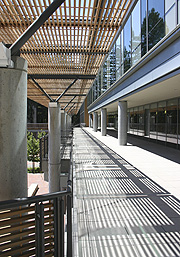September 20, 2004
New Engineering 2 Building offers state-of-the-art
facilities for research and teaching
By Tim Stephens
Completion of the Engineering 2 Building this summer has added 150,000
square feet of new office, laboratory, and classroom space on
campus, primarily for the Baskin School of Engineering.

Engineering Dean Steve Kang called the Engineering
2 Building "a huge plus, not only for the engineering
school but for the whole campus."
Photo: Jim MacKenzie
|
The project also includes the new Jack Baskin Engineering
Auditorium, a 212-seat lecture hall. A large open plaza provides
an inviting outdoor space between the Baskin Engineering Building
and Engineering 2.
Engineering Dean Steve Kang said the new building provides
a much-needed expansion of facilities for the School of Engineering.
"Faculty, graduate students, researchers, and staff have
had to bear with constant rearrangement of offices and sharing
of laboratories for many years. Finally, Engineering 2 provides
quality spaces for further development of research programs
and adequate space for our staff organizations," Kang said.
The Department of Economics has also moved into the new building,
occupying about 75 percent of the fourth floor. Programs involving
collaboration between economics and engineering, such as the
Information Systems and Technology Management (ISTM) program,
will benefit from this arrangement, Kang said.
"Having the Economics Department in Engineering 2 along
with the ISTM program will benefit not only research programs,
but also students in both programs," he said.
The top floor of the building will eventually be devoted to
two California Institutes for Science and Innovation: The Institute
for Quantitative Biomedical Research (QB3) and the Center for
Information Technology Research in the Interest of Society (CITRIS).
For now, temporary space on this floor is being used to house
faculty from the Departments of Chemistry and Biochemistry and
Molecular, Cell, and Developmental Biology, who have been displaced
by the seismic retrofitting of the Sinsheimer Laboratories Building,
combined with the delayed opening of the Physical Sciences Building.
The Baskin Engineering Auditorium is a state-of-the-art facility
for classes, lectures, and special events. Its features include
videoconferencing capabilities.
"Overall, the Engineering 2 Building, the Baskin Engineering
Auditorium, and the plaza environment are a huge plus, not only
for the engineering school but for the whole campus," Kang
said.
Engineering 2 includes two 50-seat classrooms for general assignment
and a 100-seat experimental classroom for use by the CITRIS
group for research on interactive learning environments and
advanced display technologies. All of the classrooms are fully
wired, with electrical outlets and network connections available
at every seat.
Patrick Mantey, Baskin Professor of Computer Engineering and
campus director of CITRIS, said plans for the 100-seat classroom,
called "the Simularium," include research aimed at
making large classes more interactive and effective, connecting
classrooms with students in remote locations (distance learning),
and advanced capabilities for information display, computer
graphics, and scientific visualization.
Technological innovations that will be explored in the Simularium
include a variety of large-screen display capabilities, support
for the use of displays by members of the class or audience,
and capture of displayed material to an individual's computer.
This high-tech classroom and two smaller laboratories in the
building will be used to advance and showcase CITRIS research
on the use of technology in education, Mantey said.
"The Simularium will offer a unique interactive learning
and presentation laboratory and, it is hoped, attract support
and sponsorship from industry," Mantey said.
Facilities for QB3 in Engineering 2 include a specially designed
computer room that will house a powerful new cluster of computers
for bioinformatics research and work in computer visualization
in conjunction with CITRIS. David Haussler, professor of biomolecular
engineering and campus director of QB3, said the new computer
room will complement his group's "Kilocluster," a
1024-processor array housed in the Baskin Engineering Building.
"The Engineering 2 Building gives us much-needed space
for new faculty, staff, students, and postdoctoral researchers,"
Haussler said.
Return to Front Page